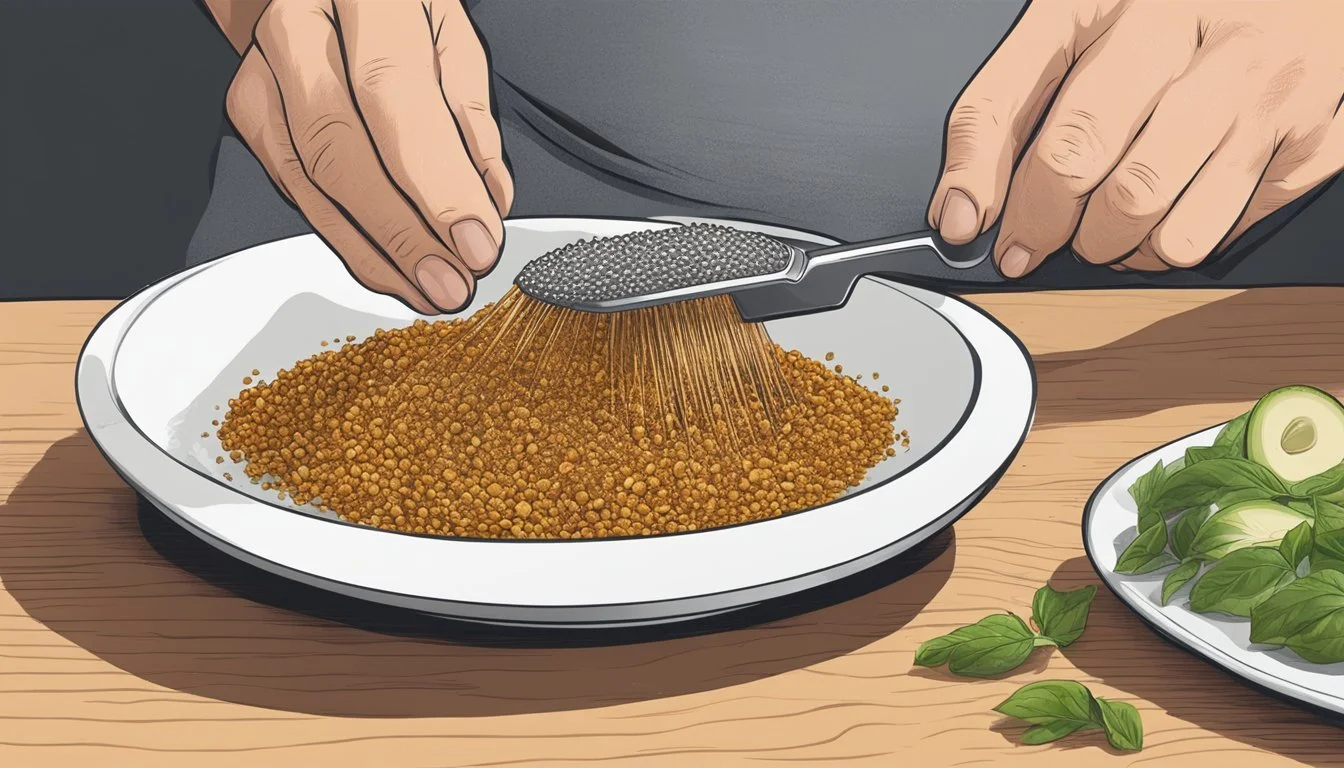How to Substitute Mace for Nutmeg
A Simple Spice Swap Guide
Mace and nutmeg are often mentioned in the same breath, as they both originate from the fruit of the nutmeg tree, Myristica fragrans. While nutmeg is the actual seed of the tree, mace is the delicate, lace-like covering that encases the nutmeg seed. Culinary enthusiasts frequently seek mace for its warm, spicy-sweet flavor, which is similar to but more subtle than the robust taste of nutmeg. When a recipe calls for nutmeg and none is at hand, mace can step in as a milder alternative.
In the context of substitutions, the balance of flavors is essential. Mace, with its nuanced flavor profile — comprising notes of citrus, cinnamon, and clove — blends seamlessly into a multitude of dishes, both sweet and savory. Chefs and home cooks alike may employ mace as a nutmeg substitute with a one-to-one ratio, adjusting to personal taste. It is especially fitting for baked goods, bechamel sauces, and spice mixtures, enhancing recipes without overwhelming them.
The choice of spices can transform a dish, and understanding the subtlety of each can be the key to culinary success. Mace, due to its compatibility with a myriad of ingredients, serves as a reliable substitute that respects the complexity of nutmeg's flavor without sacrificing the intended character of a recipe. Whether it's a pinch or a spoonful, mace can confidently take the place of nutmeg, ensuring that the intended aroma and taste of the dish are preserved.
Understanding Nutmeg and Mace
In the world of spices, nutmeg and mace hold unique positions for their intertwined origins and subtle flavor differences. Here, we explore the dimensions that set these two apart and how they contribute to culinary arts.
Origins and Botanical Background
Nutmeg and mace are products of the Myristica fragrans tree, indigenous to the Moluccas or Banda Islands of Indonesia. Historically, these islands were the sole producers of nutmeg and mace, which were coveted for their culinary and medicinal value. The tree yields nutmeg as its seed and mace from the seed’s aril, the lace-like red covering that envelops the nutmeg pit.
Culinary Uses and Flavor Profiles
Both spices feature prominently in a variety of culinary applications. Nutmeg is often associated with sweet dishes and baking, adding warm and woody notes to desserts. Conversely, mace imparts a slightly more pungent and peppery taste, making it versatile in savory dishes like meat stews and soups. While they are interchangeable to an extent, each lends a specific characteristic:
Nutmeg: sweet, woody taste; ideal for desserts and baked goods
Mace: more intense, suitable for meat, stews, and savory recipes
In spice blends, mace can be found in garam masala, contributing to its complex flavor profile, and nutmeg sometimes appears in pumpkin pie spice, enriching its warm notes.
Health and Nutritional Aspects
Health-wise, nutmeg and mace offer a range of benefits, including digestive properties and anti-inflammatory compounds. They contain similar nutritional profiles, providing fiber, vitamins, and minerals in small doses. However, they should be consumed in moderation, as excessive consumption can have adverse effects.
Availability and Price Considerations
Nutmeg is generally more readily available and less expensive than mace due to higher yield from the Myristica fragrans tree. Current price trends indicate:
Spice Average Price (per ounce) Nutmeg $2.86 Mace $3.30
Their price and availability can influence one's choice in using them as substitutes for each other in recipes.
Cultural Significance in Cooking
The spices hold a revered place in various culinary traditions. In European cooking, nutmeg is a classic addition to béchamel sauce and potato dishes. Mace's cultural roots are evident in Indian cuisine within spice blends like garam masala. Despite their exotic origins, both spices have secured their positions in the global spice cabinet due to their versatility and distinctive flavors.
Substituting Mace for Nutmeg
When a recipe calls for nutmeg and it's not available, mace can be an effective substitute. This section will guide readers through the correct quantities and ratios to use, adjustments for taste and flavor, and considerations for specific dishes.
Quantities and Ratios
For most culinary applications, one teaspoon of ground nutmeg can be replaced with one teaspoon of ground mace. However, as nutmeg possesses a slightly more pungent flavor and fragrance, it may be prudent to start with a slightly smaller quantity of mace and adjust to taste.
Taste and Flavor Adjustments
Mace tends to have a softer and more delicate flavor compared to nutmeg, with a light pepperiness and a hint of citrus. When substituting mace for nutmeg in spice blends or dishes, consider the complementary flavors in the recipe. For instance, in sweet dishes like fruit desserts and cookies, mace can enhance the flavor profile without overpowering it. In meat dishes and soups, its subtlety may enhance without the risk of the spice dominating other flavors.
Considerations for Specific Dishes
Certain recipes may be more affected by the substitution than others. Here's a brief guide:
Desserts and Baked Goods: Use mace carefully to retain the warm, spicy essence without making it too sharp.
Meat Dishes: Mace works well with meat, infusing a milder, yet compatible spice note.
Soups and Sauces: Subtle hints of spice from mace can elevate the dish without altering its intended taste.
Fruit Preparations: Mace's citrusy undertones can complement fruit-based recipes quite well.
Always taste and adjust seasonings as you cook, as the potency of spices can vary with age and brand.
Alternative Spices and Substitutions
When a recipe calls for nutmeg and it's unavailable, various other spices can serve as substitutes. The alternatives can differ in flavor intensity and complexity, requiring adjustments to achieve a desired taste profile.
Cinnamon: A Common Alternative
In recipes, cinnamon is frequently used in place of nutmeg, especially in sweet dishes like desserts. Since cinnamon has a stronger flavor, it should be used sparingly—starting with half the amount of nutmeg called for, and then adjusting to taste.
Mixing Spices for Complexity
Combining multiple spices can imitate nutmeg's complex flavor. Garam masala, a blend including mace, cinnamon, and cloves, can be a suitable substitute, particularly in savory dishes. Pumpkin pie spice is another blend that mirrors nutmeg's warm flavor profile in desserts.
Using Pre-Ground vs. Whole Spices
While pre-ground spices offer convenience, freshly ground spices from whole nutmeg using a spice grinder provide a more potent and nuanced flavor. Therefore, adjusting quantities may be necessary when substituting whole spices for pre-ground, to avoid overpowering the dish.
Utilizing Spice Blends
Spice blends like garam masala and apple pie spice are practical substitutes for nutmeg as they possess similar flavor characteristics. These blends often contain other spices, such as allspice and cloves, contributing additional layers of flavor to dishes.
Practical Tips for Cooking with Spices
When substituting mace for nutmeg or incorporating any spice into culinary creations, one should consider the freshness, potency, and harmonious pairing of spices.
Optimizing Spice Freshness and Potency
Spices, including whole nutmeg, ground cloves, and ginger, should be purchased in smaller quantities to ensure freshness. This avoids the diminished flavor that comes with staleness. Storing spices in a cool, dark place can prolong their potency. Using a spice grinder to freshly grind whole spices, such as nutmeg or black pepper, can significantly enhance the vibrancy of flavors in dishes.
Balancing Spice Mixtures
Balancing spices like cumin, coriander, cloves, and cardamom requires a delicate touch. For example, with spice mixtures, one should start with small amounts and adjust incrementally, tasting along the way. Combining complementary flavors can round out dishes, while using too much of one spice can easily overpower the others.
Creative Applications in Everyday Cooking
Spices can transform everyday dishes. Try seasoning roasted potatoes with cumin and coriander, adding a pinch of cardamom to rice puddings, or spicing up sauces and gravies with a whisper of ground ginger. Even a simple dash of ground cloves can elevate a warm apple cider.
Pairing Spices with Foods
Spices should be chosen not only for their flavor but also for their compatibility with the food they accompany. Cumin pairs wonderfully with the flavors of sausage and veal, while lighter spices like cardamom and cloves can accentuate the natural sweetness of seafood and fruits. Ground ginger works well with both sweet and savory dishes, enhancing meats without overpowering them.
Enhancing Natural Flavors and Fragrances
When substituting mace for nutmeg, one enhances the natural flavors and fragrances of dishes. Both spices come from the nutmeg tree and share complementary flavor profiles, making them versatile in a range of culinary applications.
Sweet and Savory Balance
In both sweet and savory dishes, mace and nutmeg play a crucial role in achieving a balanced flavor profile. They are especially effective in recipes involving pumpkin or meat, where their warm and slightly sweet tones complement the innate flavors. For instance, a pinch of nutmeg can elevate the taste of pumpkin pie, while mace might be used to subtly enhance the complexity of a meat stew.
Sweet Dishes: Use nutmeg for a slightly sweeter taste in desserts and baked goods.
Savory Dishes: Opt for mace to introduce a gentle, floral note to meats and savory recipes.
Adding Aromatic Depth to Dishes
Nutmeg and mace contribute a nuanced fragrance that can add depth to a variety of dishes. The floral notes of mace are particularly suited for baked goods, imparting a sophisticated aroma with hints of warmth. When using nutmeg as a substitute, it's suggested to add the spice sparingly to prevent overpowering the dish's intended bouquet.
Baked Goods: Sprinkle nutmeg to infuse pastries and breads with a warm scent.
Complex Flavors: Use mace to subtly accentuate savory dishes with its delicate, floral fragrance.
Spice-Infused Beverages
Both nutmeg and mace are popular in spice-infused beverages such as eggnog and certain rum cocktails. Nutmeg's pungent flavor profile can be particularly inviting when grated fresh atop eggnog. On the other hand, mace's softer fragrance can be used to create a less intense but equally enticing variant of spice-infused drinks.
Eggnog: Grate a touch of nutmeg on top for a classic, comforting finish.
Rum Cocktails: A dash of mace can introduce a light, distinctive character to rum-based drinks.





